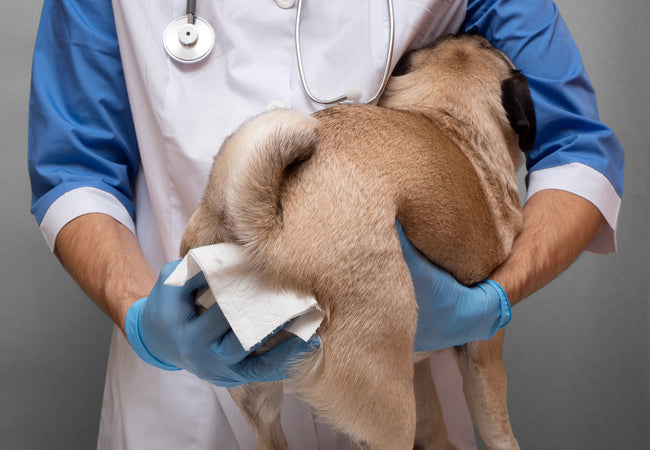Vaginal Discharge in Dogs Veterinary Guide & Care Tips 2025 🩺🐾

In this article
Vaginal Discharge in Dogs Veterinary Guide & Care Tips 2025 🩺🐾
By Dr. Duncan Houston BVSc
Hello, I’m Dr Duncan Houston BVSc, veterinarian and founder of Ask A Vet. Vaginal discharge in dogs can range from a perfectly normal part of her heat cycle to a symptom of serious illness. This comprehensive 2025 guide will help you understand when it’s safe—and when to call the vet. It includes causes, diagnosis, treatment, prevention, and real‑world support from Ask A Vet. Let’s get started! 💙🐶
1. What Is Vaginal Discharge? 🤔
Discharge can vary in color and consistency:
- BLOODY/PINK: Normal during heat (1–3 times/year).
- CLEAR/WATERY: Typical post-heat or normal vaginal cleansing.
- MUCOID/THICK: Could indicate inflammation or normal heat stage.
- YELLOW/GREEN/PURULENT: Usually signs of infection—UTI, vaginitis, or pyometra.
- BLACK/GREEN: Common after birth but can signal retained placenta if prolonged.
- FOUL ODOR: Highly concerning—often infection or pyometra.
2. Normal vs. Abnormal Discharge 🐾
Heat-cycle discharge: Bloody for ~7–10 days, then transitions to clearer fluid.
Postpartum discharge: Dark green-black or brown is normal for a few days after whelping.
Any discharge outside those contexts—especially with odor, pus, or blood in a spayed dog—warrants veterinary evaluation.
3. Common Causes & Risk Factors ⚠️
- Heat cycle (estrus/proestrus): Bloody discharge, swollen vulva.
- Pyometra (uterine infection): Often causes purulent/foul discharge, fever, lethargy—urgent.
- Vaginitis: Common in puppies and spayed adults; cloudy or mucusy discharge.
- UTI: May lead to secondary vulvar discharge.
- Retained placenta or metritis: Post-birth bleeding/infection.
- Vaginal trauma or foreign body: Often bloody discharge.
- Neoplasia (tumors, polyps): Can cause mucous or bloody discharge.
- Vulvar fold dermatitis/vestibulitis: Excess tissue causes irritation & discharge.
- Brucellosis: Persistent discharge, zoonotic concern.
4. Recognizing the Signs 🕵️♂️
Other than discharge, watch for:
- Excessive licking, scooting, or dragging.
- Swollen or red vulva.
- Frequent urination, straining.
- Lethargy, fever, vomiting—especially with pyometra.
- Bad smell or signs of pain during mating or urination.
5. Diagnostics & Testing 🔬
- History & physical exam including heat schedule, breeding, whelping history.
- Blood tests (CBC, chemistry): Check for infection or systemic illness.
- Urinalysis & culture: Detect UTIs or underlying urinary issues.
- Vaginal cytology & culture: Identify bacteria, yeast, inflammatory cells.
- Imaging (ultrasound/X‑ray): Detect pregnancy remnants, pyometra, tumors.
- Brucella testing: For chronic discharge risk.
6. Treatment Plans 🛠️
6.1 Heat cycle discharge
- No treatment needed—keep clean with sanitary wraps and monitor until discharge ends.
6.2 Pyometra
- Emergency spay (ovariohysterectomy): Required for open or especially closed forms.
- IV fluids, antibiotics, hospitalization.
6.3 Vaginitis
- Puppies: Often resolve post‑first heat with cleaning only.
- Adults: Use culture‑guided antibiotics ± topical douches.
6.4 UTI-associated discharge
- Antibiotics targeting urinary pathogens and follow‑up urinalysis.
6.5 Retained placenta/metritis
- Treated like pyometra—often needs spay and antibiotics
6.6 Trauma/foreign bodies
- Remove the object, clean the area, antibiotics if needed
6.7 Tumors or polyps
- Surgical excision + biopsy; oncology consult if cancerous.
6.8 Vulvar fold dermatitis
- Hygiene, topical therapy, episioplasty to prevent recurrence.
7. Recovery & Prognosis ✅
- Heat-cycle: full resolution with good cleaning and monitoring.
- Puppy vaginitis: usually gone after first heat.
- Adult vaginitis/UTI: resolves in 2–3 weeks with proper treatment.
- Pyometra: good recovery post-spay, but must spay to prevent recurrence.
- Tumors: variable depending on type/stage.
- Dermatitis/vestibular issues: excellent outcomes post-episioplasty.
8. Monitoring & Prevention 🛡️
- Spay to prevent heat-cycle issues and pyometra;
- Maintain hygiene with sanitary trimming and wipes after toileting ;
- Keep an eye out for changes in discharge, odor, color;
- Attend regular vet checkups—especially after heat or whelping;
- Trim fur and maintain skin folds to prevent dermatitis.
9. Help from Ask A Vet,💡
- Ask A Vet: Teletriage, cytology/urinalysis interpretation, post-op follow‑ups;
10. When to Contact the Vet ASAP 🚨
- Discharge in a spayed dog or when not in heat;
- Pus, foul smell, fever, vomiting, lethargy;
- Signs of pyometra—frequent urination, drinking, vomiting, swollen abdomen;
- Blood that doesn’t align with normal heat cycle;
- Difficulty urinating or incontinence.
11. Final Thoughts 📝
Vaginal discharge in dogs can be normal—but recurrent, odorous, bloody, or purulent discharge calls for attention. Accurate diagnosis, targeted treatment, and proactive prevention are key. With expert tools and support from Ask A Vet, you’ll have confidence managing your dog’s reproductive and urinary health through 2025 and beyond. 🐾💙
If you observe abnormal discharge or related symptoms, schedule a telehealth consult via AskAVet.com, and download our app for tailored follow‑up plans and reminders. 🌟






